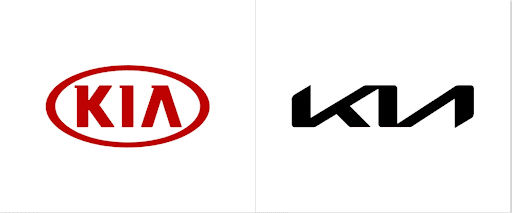Is your brand still resonating with your audience, or is it time for a change? In the ever-evolving market, brands need to stay relevant to remain relevant and drive growth. Rebranding offers businesses a powerful opportunity to redefine their identity, and connect with a broader audience. Reason why, almost 74% of top public listed companies rebrand themselves within 7 years.
But what exactly is rebranding, and how can it be effectively executed? Whether you are considering a complete overhaul or a subtle brand refresh, this guide will walk you through the intricacies of rebranding, from understanding its importance to learning from successful examples.
What is Rebranding?
At its core, rebranding is the process of changing the corporate image of an organisation. It could involve altering the logo, name, design, or communication strategy to reflect a new direction.
Companies typically rebrand to realign with new market opportunities, respond to competitive pressures, or reflect a shift in their overall brand strategy. Understanding what rebranding entails helps companies make informed decisions on how to effectively reposition themselves.
Different Types of Rebranding
Before embarking on a rebranding journey, it is important to determine which type of rebranding suits your business needs. Here are the key types:
1. Complete Rebranding
A complete rebranding involves a total transformation of a company’s identity. This may include changing the company’s name, logo, colours, tagline, and overall messaging. This approach is often necessary when a business is going through significant changes, such as mergers, acquisitions, or a shift in its core offerings.
It requires thorough planning and careful execution to ensure a smooth transition and positive reception from the target audience. Complete rebranding involves content rebranding of the website, social media, and entire digital presence. In such cases, hiring a top content marketing agency is essential.
2. Partial Rebranding
In a partial rebranding, some elements of the brand are updated while others remain intact. This type is usually employed when a brand wants to modernise its image or appeal to a new audience without losing its core identity. A brand might change its logo or revamp its website while retaining its original values and customer base.
3. Brand Refresh
A brand refresh is a more subtle update of a company’s visual identity, such as tweaking colours, fonts, or imagery, to keep the brand current. This is often a necessary step for businesses that want to remain relevant in a fast-paced market but do not need a major overhaul. The essence of the brand stays the same, but the visual and emotional aspects are enhanced to keep up with trends and customer expectations.
How to Rebrand a Company?
Rebranding requires careful planning and execution. It is not just about changing your logo or colours, it is about creating a new identity that resonates with your audience and reflects your company’s mission. Here are the steps involved:
1. Set Objectives
Start by defining what you want to achieve through rebranding. Are you aiming to reach a new target audience, reposition yourself in the market, or modernise your brand’s look and feel? Clear objectives will guide every decision in the rebranding process and ensure that your efforts align with your business goals.
2. Analyse the Current Brand
Conduct an in-depth analysis of your current brand. Identify which aspects are working well and which ones are not resonating with your audience. This includes evaluating brand messaging, visual identity, and customer perceptions. Understanding the strengths and weaknesses of your existing brand will help inform your rebranding strategy.
3. Identify the Target Audience
Rebranding is not just about your company; it’s about how your customers perceive you. Identify who your target audience is and what they expect from your brand. This will ensure that the new brand identity speaks directly to their hopes, desires, and pain points. If your audience has shifted over time, your business rebrand should reflect that change.
4. Competitor Analysis
Understanding the competitive landscape is crucial in rebranding. Analyse your competitors to see how they position themselves in the market and identify opportunities for differentiation. This analysis will help you create a unique brand identity that stands out from the competition and appeals to your target audience.
5. Develop Your Rebranding Plan
Once you have a clear understanding of your objectives and the competitive landscape, the next step is to develop a comprehensive rebranding plan. This plan should outline all the steps involved in the rebranding process, including timelines, budgets, key milestones, and the roles of different team members. A well-structured plan ensures that the process of rebranding a business is organised, efficient, and aligned with your business goals.
6. Design New Brand Elements
The visual and verbal elements of your brand are crucial in conveying your new identity. Work with skilled UI and UX designers and copywriters to create new logos, colour schemes, fonts, taglines, and other brand elements that reflect your rebranded identity. These elements should resonate with your target audience and be consistent across all platforms, from your website to your social media channels.
7. Implement the Rebranding Internally
Before launching your new brand externally, it is important to ensure that your internal team is fully on board. This involves training employees on the new brand identity, updating internal documents and systems, and ensuring that everyone understands the reasons behind the rebrand. Internal alignment is crucial for maintaining a consistent brand message and ensuring a smooth transition.
8. Roll Out the Rebranding Externally
Finally, launch the rebranding to the public. This involves updating your website, social media profiles, marketing materials, and any other customer-facing platforms. A well-executed external launch should include a clear communication strategy that explains the rebrand to your audience, highlights the reasons behind it, and emphasises the benefits for them.
Consider using a mix of marketing channels, such as email campaigns, press releases, and social media content announcements, to maximise reach and impact of you rebranding.
7 Excellent Rebranding Examples to Learn From
Rebranding is a powerful tool that can redefine a company’s identity and align it with new business objectives. Here are seven notable examples of successful rebranding efforts that provide valuable insights and inspiration:
1. Facebook/Meta

In October 2021, Mark Zuckerberg announced a major rebranding of Facebook, rebranding the parent company to “Meta.” This change was not just cosmetic; it reflected a significant shift in the company’s focus.
Meta now oversees Facebook, WhatsApp, Instagram, Messenger, and other products, positioning itself at the forefront of the metaverse, augmented reality (AR), and virtual reality (VR).
The rebrand involved a new name, logo, and typeface, along with the launch of a new website, meta.com. The rebrand was driven by the company’s vision to move beyond social media and embrace immersive digital experiences, showcasing how a rebrand can signal a strategic shift in a company’s future direction.
- Key Changes: New name, logo rebranding, typeface, and website (Meta.com)
- Motivation: Broaden scope beyond social media, focus on metaverse and AR/VR
- Lesson: Align brand identity with evolving company vision and future goals
2. Pepsi

Pepsi has a long history of rebranding, with multiple logo changes over the years. One of the most talked-about rebrands was conceptualised by Arnell Group, who developed Pepsi’s “Breathtaking” brand strategy. They drew inspiration from science and design principles reminiscent of Leonardo da Vinci’s work, linking the new logo to concepts like Mona Lisa’s proportions, gravitational forces, and magnetic fields.
However, this rebrand faced criticism for being overly complex and confusing, with a hefty price tag of $1 million. While Pepsi’s rebranding history showcases innovation, it also serves as a reminder that overcomplicating a rebrand can sometimes backfire.
- Key Changes: New logo design based on complex scientific and artistic concepts
- Cost: $1 million
- Outcome: Confusion and criticism from consumers and brand experts
- Lesson: Balance creativity with clarity and avoid over-complicating brand messages
3. KIA

In 2021, Korean automaker KIA introduced a bold new logo and slogan, “Movement that inspires,” marking a significant rebranding effort. The company dropped “Motors” from its name to emphasise its transition into electric mobility and innovation.
The new logo, featuring angled letters that resemble a handwritten signature, symbolises KIA’s commitment to change and high ambitions. Alongside the rebrand, KIA revamped its approach to car design, shifting from conservative aesthetics to bold, eye-catching designs.
This rebrand successfully positioned KIA as a forward-thinking brand in the rapidly evolving automotive industry.
- Key Changes: New logo, slogan (“Movement that inspires”), and company name (removed “Motors”)
- Motivation: Showcase transition to electric mobility and innovation
- Visual Impact: The logo resembles a handwritten signature with angled letters
- Lesson: Use rebranding to signal significant shifts in company direction and product design
4. Zomato/Eternal

In a recent move, the CEO of Zomato Ltd. Deepinder Goyal announced on LinkedIn about renaming the parent company behind the food delivery app, BlinkIt etc. from Zomato to Eternal. This marks as one of the vital changes introduced by the famed food delivery giant turned into a multibrand enterprise.
While the company maintains its strong foothold as a public listed enterprise across NSE & BSE, this move can be seen as a way to consolidate the reputation of the 4 key brands under a distinct parent brand without drawing all focus on only a particular service like food delivery.
- Key Changes: Consolidated 4 brands (Zomato, BlinkIt, District, and Hyperpure) under an umbrella enterprise
- Timing: Entry into BSE SENSEX
- Motivation: Strengthen shareholders’ focus across the entire brand portfolio
- Lesson: Affirm the long-term enterprise goals through a distinct identity
5. SBI (State Bank of India)

The State Bank of India (SBI), the nation’s largest and most iconic bank, embarked on a rebranding journey to adapt to the digital age. The bank sought to modernise its identity while maintaining its legacy of trust and reliability.
SBI’s new brand identity retains its signature blue colour, symbolising trust, while incorporating a more dynamic and energetic look. This rebrand was designed to make the bank appear more open and approachable, bridging the gap between its rich history and the demands of a digitised world.
- Key Changes: Updated visual identity while retaining core brand colours
- Motivation: Reflect shift towards digital products and services
- Approach: Balance between legacy and modernity
- Lesson: Adapt traditional brands for the digital age without losing established trust
6. Hero MotoCorp

Following its demerger from Honda, Hero MotoCorp underwent a rebranding to establish itself as a standalone brand. Previously associated with Honda, Hero faced the challenge of competing against a well-known partner.
In 2011, Hero MotoCorp launched a new brand anthem, “Hum Mein Hai HERO,” composed by A.R. Rahman. This campaign struck a chord with Indian consumers, successfully positioning Hero as an independent and emotionally resonant brand.
The rebrand helped Hero MotoCorp solidify its identity in the competitive automotive market.
- Context: Separation from Honda, rebranding as “Hero MotoCorp”
- Key Strategy: Launch of the emotional brand anthem “Hum Mein Hai HERO”
- Lesson: Leverage emotional connections to reestablish brand identity after major corporate changes
7. Dunkin’ (formerly Dunkin’ Donuts)

In January 2019, Dunkin’ Donuts officially rebranded as “Dunkin’,” dropping the “Donuts” from its name. This change signified the company’s strategic shift to focus more on coffee and beverages, while still honouring its heritage.
Despite the name change, Dunkin’ retained its recognisable pink and orange colour scheme and iconic font, ensuring brand continuity. According to Tony Weisman, Chief Marketing Officer of Dunkin’ U.S., the simplified name and modernised brand identity created a fresh energy for Dunkin’ both in and outside of its stores. It provides that sometimes less is more in a successful rebrand.
- Key Change: Removed “Donuts” from the brand name
- Motivation: Emphasise focus on coffee and broader menu offerings
- Retention: Kept iconic colours and font to maintain brand recognition
- Lesson: Simplify brand name to reflect diverse product range while preserving visual brand elements
Tips for Successful Rebranding
Rebranding is a complex process that requires careful consideration and execution. Here are some tips to ensure your rebranding efforts are successful:
1. Refocus Through Research
Before making any changes, conduct thorough research to understand market trends, customer expectations, and the competitive landscape. This research will inform your rebranding strategy and ensure that your new brand identity is relevant and compelling.
2. Find Inspiration in Customers
Your customers are a valuable source of insights and inspiration. Use customer feedback, surveys, and social listening tools to understand what your audience values most about your brand and what they would like to see improved. This information can guide your rebranding decisions and help you create a brand that resonates with your target audience.
3. Look to the Past to Find Your Future
Your brand’s history can be a rich source of inspiration for your rebrand. Reflect on your company’s origins, core values, and past successes to create an authentic and forward-looking brand identity. This approach ensures that your rebrand is rooted in your brand’s true essence while positioning you for future growth.
4. Commit to What You Stand for
Your brand should be a reflection of your company’s values and mission. When rebranding, ensure that your new brand identity aligns with what you stand for and that you communicate this clearly to your audience. A strong, value-driven brand identity fosters customer loyalty and differentiates you from competitors.
5. See the Brand as a Full Experience
Rebranding is not just about visual changes, it is about creating a cohesive and memorable experience for your customers. Consider every touchpoint where customers interact with your brand, from your website and social media to customer service and product packaging.
Ensuring a consistent and positive brand experience across all channels will reinforce your new brand identity and build stronger connections with your audience.
6. Brand for Your Future Company
Your rebrand should not only address your current needs but also position your company for future growth. Consider where your business is headed and how your new brand identity can support your long-term vision. A forward-looking rebrand ensures that your brand remains relevant and competitive in the years to come.
Challenges for a Successful Rebranding
Rebranding is not without its challenges. Being aware of potential pitfalls can help you navigate the process more effectively:
1. Trying to Be Something You are Not
It is important to stay true to your brand’s core identity during a rebrand. Trying to project an image that does not align with your company’s values or capabilities can lead to a lack of authenticity and erode customer trust. Focus on enhancing your existing strengths rather than trying to become something entirely new.
2. Losing Your Identity
While change is necessary, it is important not to lose sight of what makes your brand unique. Drastic changes that disregard your brand’s heritage or alienate your loyal customer base can backfire.
Strive to balance innovation with continuity, ensuring that your rebrand feels like a natural evolution of your brand rather than a complete departure.
3. Overcomplicating the Concept
Simplicity is key to effective branding. Avoid overcomplicating your rebrand with too many elements or messages. A clear, concise brand identity is easier for customers to understand and remember. Focus on the most important aspects of your brand and communicate them effectively.
4. Changing Everything All at Once
While it might be tempting to overhaul everything at once, a phased approach to rebranding can be more effective. Gradual changes allow your audience to adjust to the new brand identity and reduce the risk of overwhelming them. Additionally, a phased rollout can provide opportunities to gather feedback and make adjustments along the way.
5. Designing in the Dark
Rebranding decisions should be data-driven and informed by market research, customer insights, and competitive analysis. Avoid making design and branding choices based solely on personal preferences or internal opinions. Involving stakeholders and gathering external feedback can lead to a more successful rebrand.
6. Ignoring the Launch
The success of your rebrand depends not only on the quality of the rebranding process but also on how effectively you launch it to the public. A poorly executed launch can confuse customers and undermine the impact of your rebrand.
Plan a comprehensive launch strategy that includes clear communication, marketing campaigns, and customer engagement to ensure a smooth transition and positive reception.
Takeaway
Rebranding is more than just changing a logo or a name; it is about realigning your brand with your company’s evolving mission, vision, and market position.
A well-executed rebrand can revitalise a brand, attract new customers, and ensure long-term relevance. However, it must be approached with careful planning, clear objectives, and a commitment to maintaining the essence of what makes your brand unique.
By learning from these successful rebranding efforts, businesses can navigate the complexities of rebranding with confidence and achieve lasting success in a dynamic marketplace.
Frequently Asked Questions
1. Is rebranding only about changing the logo?
No, rebranding often goes beyond visual changes. While updating the logo is common, rebranding can also involve changes to the company’s mission, values, messaging, and overall market positioning.
2. Should a company involve its customers in the rebranding process?
Involving customers in the rebranding process can be beneficial, as it provides valuable insights into customer preferences and helps ensure that the new brand resonates with the target audience. This can be done through surveys, focus groups, or social media polls. Engaging customers early on can also help build anticipation and excitement around the rebrand.
3. How can a company measure the success of a rebrand?
The success of a rebrand can be measured through various metrics, such as brand awareness, customer perception, sales growth, and market share. Surveys, social media sentiment analysis, and website traffic are also useful tools for gauging how well the rebrand has been received.
Monitoring these metrics over time helps companies understand the impact of the rebrand and make necessary adjustments.
4. How long does a typical rebranding process take?
The duration of a rebranding process can vary greatly depending on the scale and complexity of the changes. A minor refresh might take a few months, while a comprehensive rebrand for a large corporation could take a year or more to plan and implement fully.
5. What are the risks of rebranding, and how can they be mitigated?
Rebranding carries risks, such as alienating existing customers, diluting brand equity, or confusing the market.
To mitigate these risks, companies should conduct thorough market research, maintain a clear and consistent message throughout the rebrand, and engage with key stakeholders, including employees, customers, and partners, to ensure buy-in and smooth transition.
Subhodip Das is the founder and CEO of Das Writing Services Pvt. Ltd. He has an experience of 12 years in the field of Digital Marketing and specialises in Content Writing and Marketing Strategies. He has worked with well-established organisations and startups helping them achieve increased Search Engine Rank visibility. If you want to grow your business online, you can reach out to him here.




Leave a comment